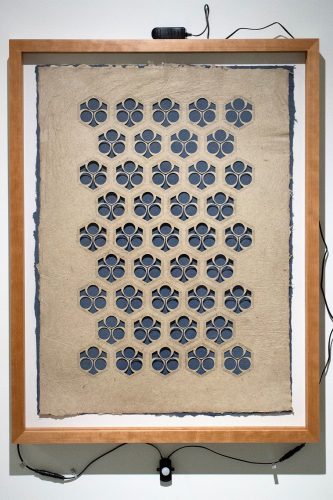
Garrick Imatani’s Monologue is one exhibit in Dismantling the House, a series of public programs and exhibitions curated by Yaelle Amir, the 2020-2021 curator-in residence at University of Oregon’s Center for Art Research. It is on display at Eugene Contemporary Art’s ANTI-AESTHETIC gallery until May 1, and there’s also an online version available at Monologue.Glitch.me.
During our meeting, Imatani wants to take me through the virtual reality version of his show. In order to share his screen, though, I have to learn how to change hosts first. I was the one who sent the Zoom invite, so the switch is necessary in order for him to take control. Doing this, I feel like we are acting out a central tenet of Monologue: that “experience is mediated.”
Imatani is a professor of art at Pacific Northwest College of Art. Though he employs VR (virtual reality) in his work, he is not into it for its own sake. He uses the technology as needed, to serve a purpose or to include something in a show that wouldn’t have been possible any other way. In this exhibit, he uses VR to mimic the interactive experience viewers have in the gallery, and to include a “merch store” that doesn’t exist in the real space.
One of the artworks in the show is an image of the artist’s family crest, passed to him from his mother’s side. It’s probably not a correct use of the crest, he says. He has manipulated the design by repeating it into an overall pattern. When people approach they set off LED lights and a secondary image appears of little frowning faces, not unlike emoticons, inside each crest.
Being fourth-generation Japanese American — his great grandfather worked on the railroad — Imatani is distanced from his ancestry but at the same time aware how his cultural background, especially the Japanese aesthetic, is represented stereotypically by “the academy” (academic institutions) and by Western culture in general.
All the art in the show represents more or less traditional Japanese objects or images. But they each violate traditional or stereotypical expectations when LED lights are set off. The images change depending on the viewer. If I told you anymore then I’d ruin the surprise — the fun.
Just know that Imatani’s artwork, though delivered with humor, is about issues he takes seriously. During our meeting he is quick to point out that there’s only one biological race of humans. His point is well taken. It means that all the talk about different races is mediated through cultural experience.
Besides providing at-home viewers access to his show, the VR experience is important, he says, because it replicates the different ways we engage. That’s another way of stating that experience is mediated. The virtual exhibit is available to viewers in the physical gallery, too. Access the virtual space while in the real space and you’ll find the merch store. You’ll also have access to a highly entertaining video.
Humor is found throughout the exhibit, but the videos are funny in the way some reality shows are, which is often at the star’s expense. In one scene, Imatani learns how to write his name in Japanese. He refers to his teacher as a “language expert” and asks the Japanese speaker a simple but moving question.
“How do I pronounce my name?”
The question speaks to the distance between him and his heritage. Then afterwards, the expert speaks to the camera alone confession style as he pokes fun at the seriousness of the artist’s efforts. I laugh but also relate. As a first-generation American, I feel worlds away from the cultures in which my parents were raised. I can’t help but wonder, how important is it, if at all, to know how to say or spell my name in its original form? ν
See Monologue at ANTI-AESTHETIC, 245 W. 8th Avenue, through May 1. Open noon to 4 pm Fridays and Saturdays by appointment only; contact EugeneContemporaryArt.com/appointments.
The issue of cultural loss was central to an April 18 discussion related to the exhibit in which Garrick Imatani, Lynn Yarne and Lu Yim talked about their Asian American cultural identity in relation to making art. The discussion can be viewed online at Calendar.UOregon.edu.